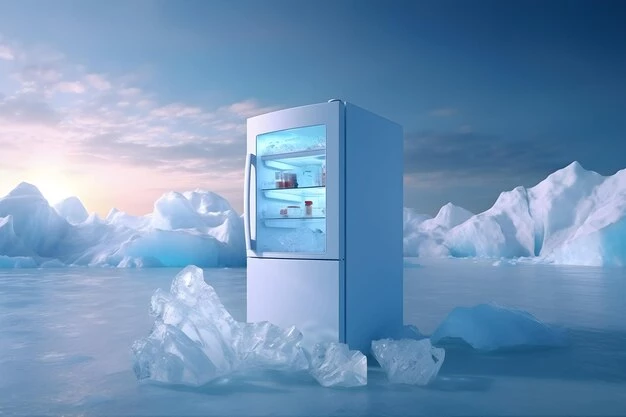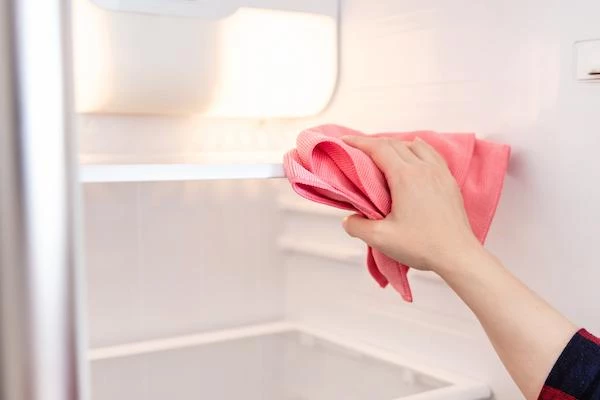Не завжди поява вологи на стінках холодильного або морозильного відсіку спричинена поломкою апарату. Зазвичай поява конденсату на задній стінці відсіку спричинена конструктивними особливостями апарату, а на полицях, бічних поверхнях, на продуктах чи під контейнерами – відсутністю профілактики чи помилками експлуатації.

У цій публікації майстри сервіс-центра odessa-remont.com.ua спробують розібратися у причинах утворення конденсату: у яких випадках це явище є природним процесом, а коли потрібно розморозити апарат чи звернутися за допомогою до професіоналів.
Чому з’являється конденсат всередині холодильника
У крапельних холодильниках конденсат, що накопичується на задній стінці холодильної камери, є нормальним процесом. Це пов’язано з принципом автоматичного розморожування апарату: під час роботи мотор-компресорного модуля, вся волога спрямовується до найхолоднішого місця (за стінкою розташований випарник), а під час паузи вона конденсується і стікає в дренажний отвір, а потім виводиться назовні камери. Але якщо волога з’являється в інших місцях відсіку або її занадто багато, потрібно шукати причину та вживати відповідних заходів. Адже зайва волога — це чудове середовище для розмноження мікробів і, відповідно, скорочення терміну зберігання продуктів.
Причини появи конденсату, з якими можна впоратися самостійно
Конденсат на внутрішніх поверхнях відсіків холодильника може з’явитися з таких причин:
- Через нещільно зачинені дверцята. У таких випадках всередину камери проникає тепло, яке взаємодіє з більш прохолодними частинами апарату та продуктами, і на них утворюється конденсат. Перевірте, чи не перешкоджають поміщені всередину відсіку ємності та посуд закриттю дверей. Після кожного «заглядання» в холодильник, перевіряйте щільність закривання. Якщо ви часто забуваєте закрити дверцята, вибирайте апарати з функцією сигналізації про положення дверей.
- При неправильній орієнтації апарату за рівнем. У таких випадках дверцята камер можуть відчинятися мимовільно (особливо якщо холодильник нахилений вперед). За відсутності сигналізації, про відкриті двері ви дізнаєтеся тільки при наступному “візиті” в холодильник. За цей час продукти та внутрішня фурнітура апарату покривається конденсатом. Перевірте, чи правильно вирівняно холодильник за рівнем. У разі потреби скоригуйте його положення.
- У разі зберігання у відсіках рідких продуктів у відкритій тарі. При охолодженні вони випаровуються і волога поширюється камерою, осідаючи на полиці та інші продукти.
- При постановці у відсіки продуктів, що не остигли. У таких випадках повітря навколо встановленої в камеру ємності нагрівається і волога, що утворюється біля них осідає всередині камери на холодних предметах.

Усуньте ці причини і не допускайте надалі таких ситуацій і ви назавжди позбудитесь конденсату на полицях свого холодного друга.
Поломки, що призводять до появи конденсату
Не завжди вдається позбутися зайвої вологи всередині холодильника, усунувши власні помилки в експлуатації. Іноді причиною появи конденсату стають поломки апарату, які потребують викликати майстра з холодильників.
Найчастіше це:
- Поява засмічення в дренажному каналі. У таких випадках конденсована на задній стінці волога не виводиться назовні через дренаж, а опускається на дно відсіку і замерзає там, утворюючи крижану кірку. Прочистіть дренаж за допомогою штатного пристрою або використовуючи дріт. Після цього дренажну трубку потрібно промити теплою водою. Якщо трубка перемерзла – розморозьте апарат.
- Зносився, втратив властивості або розірвано ущільнювач дверей. Через пошкоджене місце тепло проникає всередину камери і стає причиною появи конденсату. Встановіть новий ущільнювач і волога не проникатиме в камеру.
- Розбовтався петльовий механізм кріплення дверей. У таких випадках двері зачиняються з «перекосом» і повітря легко проникає всередину відсіку. Налаштуйте або замініть петлі.
- Втратив параметри або вийшов з ладу термодатчик (термостат у електромеханічних версіях). Через це холодильник переморожує та утворюється дуже багато рідини, яка не встигає виводитися назовні. Замініть несправну деталь.

Так же майстри сервіс-центру рекомендують звичайне позбавлення настирливого конденсату позачергове ручне розморожування. При цьому всі замерзлі системи перетворюються на «вихідний стан» і починають працювати належним чином.


 4294
4294












